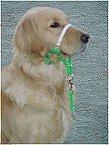Often, we are confronted with a dog that has been "spoiled" and, as a
result, has become headstrong. The dog pulls while being walked and/or jumps
up. In some cases, the canine student has learned to respond aggressively
when meeting other dogs or people. Most canine owners do not realize how much
their behavior and reactions promote these negative responses and tend to
make matters worse by pulling and yelling. Using treats to redirect attention
while the dog is distracted rarely works. A frenzied animal will not care
about the food, only about reaching the object of its contention.
The absolute worst thing a trainer could do in this situation is to
further incite the dog by using a painful training technique. Yanking the dog
by the neck, shocking him or pinching with a prong collar, all fall into this
category. Since Alice DeGroot invented head halters for dogs in the late
1970's there has been little need for using these negative reinforcement
training methods.
Head halters teach dogs in a way they understand.
How often do dogs choke or shock each other? How often do they hit?
Never. These behaviors are not in the canine repertoire. When one dog
corrects another dog it will growl in a low tone. Often, the dominant dog
will push the other dog downwards by the neck or muzzle. When a mother dog
corrects her pups she puts their muzzle or other part of their face in her
mouth and gently pushes downward as she growls.
Head halters work the same way.
When correcting the dog, pressure is applied to the dog's muzzle as the
trainer "growls" a verbal correction. The dog immediately recognizes this
communication and responds. The dog is humbled. Within a short time a dog
that is charging aggressively is stopped and taught to control the outburst.
All without pain!
A dog that insists on pulling on the leash is quickly taught to heel.
Often in less than 10 minutes with the proper use of a head halter. Where the
head goes, the body follows. How can a dog run toward another dog if his head
cannot first turn to look at the other dog? Hence, he learns to watch his
handler and ignore distractions.
There are currently over five different types of head halters on the
market. These are broken down into two types: Conventional and Figure 8. The
conventional head halter was the type developed by Alice DeGroot, DVM. It
most resembles a horse halter. It offers freedom of jaw movement and is the
least likely to irritate the eyes, for it is worn loosely. The figure 8 head
halter is worn tighter, often causing eye irritation and restricted jaw
movement. Both work equally well when it comes to teaching basic obedience.
In many cases, however, the conventional head halter may be easier for the
dog to remove than the figure 8 halter. However, this will not be problematic
provided the handler keeps a vigilant eye on the dog while the head halter is
in use. No dog should ever be left alone while wearing a head halter.
The most recent head halter to be introduced on the market is the Comfort
Trainer. The Comfort Trainer is a conventional head halter, much like Alice
DeGroot's K-9 Kumalong. It offers freedom of jaw movement, remains below the
sensitive eye area, and is made of a non-slip soft material. Dogs adjust to
the use of the Comfort Trainer far faster than any other head halter
currently on the market.
Not every dog requires the use of a head halter for training. Many will
respond well to click and treat or lure and reward methods. There are some
dogs that feel so humiliated while wearing a head halter that other methods
should be investigated. However, when one meets a dog that, when aroused,
does not care about food or toys, head halters offer a humane alternative to
painful training methods.
Miriam Fields-Babineau has been a professional animal trainer for over 20
years. She has published 20 books on the subject, including Dog Training with
a Head Halter, published by Barron's Educational Series, Feb. 2000. Her head
halter design, Comfort Trainer, is currently undergoing the patent
application process, but is available to those who wish to use a head halter
that offers comfort to the dogs and efficient utility to the handler.
Next month:
Canine Vocal Communication
Tips Archives




